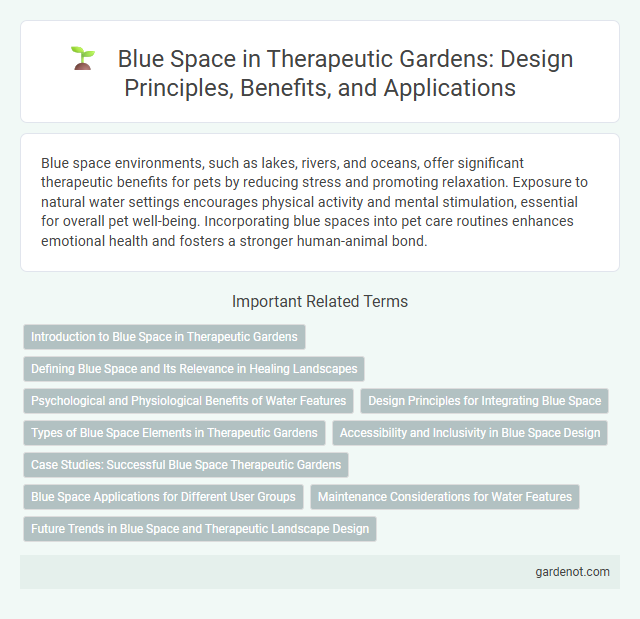Blue space environments, such as lakes, rivers, and oceans, offer significant therapeutic benefits for pets by reducing stress and promoting relaxation. Exposure to natural water settings encourages physical activity and mental stimulation, essential for overall pet well-being. Incorporating blue spaces into pet care routines enhances emotional health and fosters a stronger human-animal bond.
Introduction to Blue Space in Therapeutic Gardens
Blue space in therapeutic gardens refers to the integration of water elements such as ponds, fountains, and streams to enhance mental well-being and promote relaxation. These aquatic features help reduce stress, improve mood, and facilitate cognitive restoration through sensory engagement and natural soundscapes. Incorporating blue space in healing environments creates a multisensory experience that supports emotional balance and physical recovery.
Defining Blue Space and Its Relevance in Healing Landscapes
Blue space refers to natural or man-made aquatic environments such as oceans, lakes, rivers, and ponds that contribute to mental and physical well-being through their calming visual and auditory stimuli. Its relevance in therapeutic landscapes lies in the ability of water bodies to reduce stress, promote relaxation, and enhance recovery by fostering a sense of tranquility and connection with nature. Integrating blue space into healing environments supports restorative experiences and improves overall health outcomes in designing wellness-centered spaces.
Psychological and Physiological Benefits of Water Features
Blue space, such as lakes, rivers, and oceans, significantly enhances mental well-being by reducing stress, anxiety, and depression through calming sensory experiences. Exposure to water features promotes physiological benefits including lowered blood pressure, improved cardiovascular health, and enhanced immune function due to increased relaxation and physical activity opportunities. Interaction with blue space environments also supports cognitive restoration, attention recovery, and emotional regulation, contributing to overall psychological resilience.
Design Principles for Integrating Blue Space
Design principles for integrating blue space into therapeutic landscapes emphasize accessibility, naturalistic features, and water quality. Incorporating elements such as gently sloping shorelines, seating areas with views of water, and diverse aquatic vegetation enhances psychological well-being and promotes relaxation. Maintaining clean, safe water through sustainable management practices supports health benefits and ecological balance in therapeutic settings.
Types of Blue Space Elements in Therapeutic Gardens
Blue space elements in therapeutic gardens include water features such as ponds, streams, fountains, and reflecting pools that promote relaxation and stress reduction. These aquatic components support mental restoration by providing soothing sounds, visual calmness, and opportunities for sensory engagement. Incorporating dynamic elements like waterfalls or gentle water movement can enhance the therapeutic experience by stimulating positive emotional responses and improving overall well-being.
Accessibility and Inclusivity in Blue Space Design
Accessibility and inclusivity in blue space design ensure equitable access to water environments such as lakes, rivers, and coastal areas for individuals with diverse physical abilities and cultural backgrounds. Incorporating universal design principles, adaptive infrastructure, and multilingual signage fosters engagement and therapeutic benefits for all community members. Prioritizing these elements enhances the restorative potential of blue spaces, supporting mental health and social cohesion.
Case Studies: Successful Blue Space Therapeutic Gardens
Case studies of successful blue space therapeutic gardens demonstrate significant improvements in mental health and stress reduction among users. Locations such as the Healing Waters Garden in Singapore and the Blue Health Initiative in the UK showcase how integrating natural water elements like ponds, fountains, and coastal views promotes psychological well-being. These projects highlight the therapeutic benefits of blue spaces by combining restorative environments with social interaction and physical activity opportunities.
Blue Space Applications for Different User Groups
Blue space applications enhance well-being by providing calming environments for diverse user groups, including urban residents, elderly populations, and mental health patients. Recreational activities such as swimming, kayaking, and nature observation in blue spaces improve physical health and reduce stress across age and health conditions. Design features like accessible waterfronts and sensory gardens optimize therapeutic benefits for individuals with mobility limitations or cognitive impairments.
Maintenance Considerations for Water Features
Regular maintenance of blue space water features is crucial to prevent algae growth, sediment buildup, and water contamination, ensuring optimal therapeutic benefits. Implementing filtration systems and routine cleaning schedules supports water clarity and quality, enhancing aesthetic appeal and user safety. Sustainable practices, such as using native aquatic plants and biodegradable cleaning agents, reduce environmental impact while maintaining the ecological balance of therapeutic landscapes.
Future Trends in Blue Space and Therapeutic Landscape Design
Future trends in blue space and therapeutic landscape design emphasize integrating natural water bodies with urban ecosystems to enhance mental health and well-being. Innovations include multisensory environments that combine visual, auditory, and tactile experiences to maximize therapeutic benefits. Advances in technology support real-time monitoring of environmental quality, ensuring safe and accessible blue spaces for diverse populations.
Blue space Infographic

 gardenot.com
gardenot.com